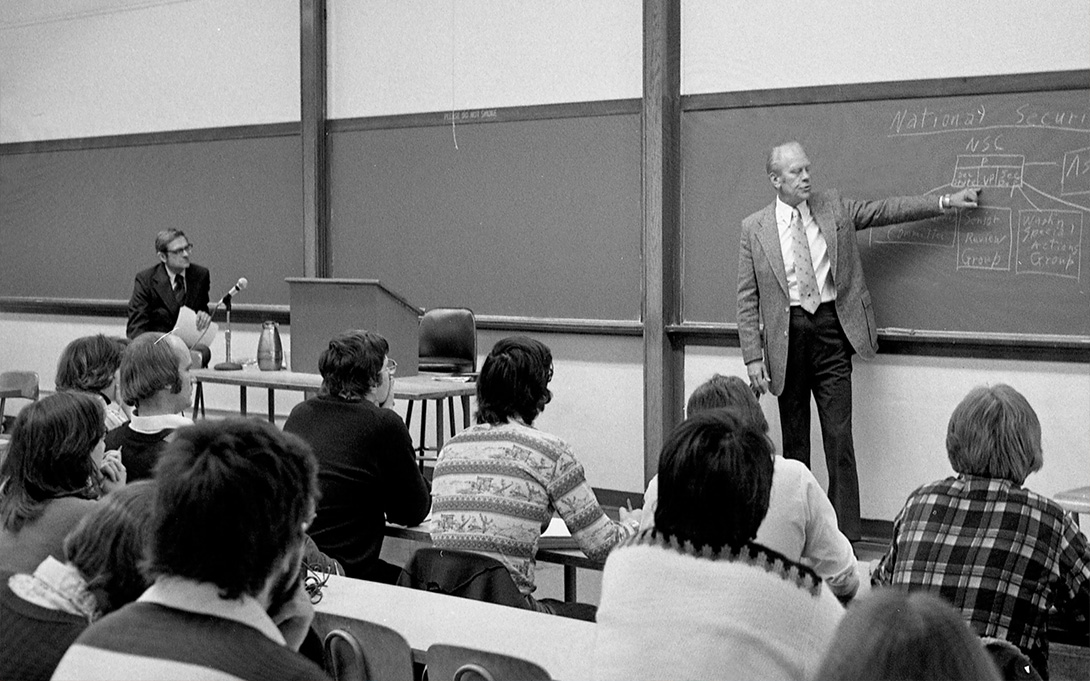
The Michigan Heritage Project has examined the legacy of President Gerald Ford's stint as a professor at the University of Michigan.
The full article can be read here.
(Additional articles about the Ford legacy can be seen on the Ford School website here.)
"Jerry Ford was coming home as a foreigner. The University of Michigan knew him as a star football player, earning three varsity letters and Most Valuable Player honors as a senior in 1934. He returned to campus as a longtime congressman representing Grand Rapids, as vice president to embattled President Richard M. Nixon, and as the 38th president of the United States. He designated U-M as the repository for his papers, and used Crisler Arena to kick off his re-election campaign in 1976 in hopes of securing the presidency on his own terms. But he had never stepped on campus bearing the title he did in the spring of 1977: Professor Gerald R. Ford."
The article traces the steps that then-U-M President Robben Fleming took to persuade Ford to come to campus. "'We should be eager to have you on campus for as long or as often as you wish. This might range from visits of a few days to visits of a whole academic year, with any kind of time in between those two extremes,' Fleming wrote in early December when inviting Ford to U-M."
"In the last week of January [1977], the Board of Regents appointed Ford as an adjunct professor of political science – even though the president himself had not finalized a visit. A week later, Ford confirmed he would come to campus in the first week of April. It represents the only time an American president – sitting or former – has taught at U-M."
Once on campus, his schedule was rigorous: “'I have been told that thus far, not counting this class, I have had 10 other classes, three breakfasts, four luncheons, three dinners, four meetings, answered 372 questions and, according to student intelligence, used three different restroom facilities on campus,' Ford scribbled in his notes for his last course. All told, he interacted with some 1,500 students."
"There was a strong emphasis on maintaining an academic atmosphere in the classes where Ford spoke. Lecturing in Angell Hall, Rackham Auditorium and Lane Hall, Ford covered a wide swath of presidential life. He touched on the seizing of the American merchant ship Mayaguez, the Electoral College, his Whip Inflation Now (WIN) campaign, and the Strategic Arms Limitation Treaty. Classes typically operated in a question-and-answer format, as did meetings with various student organizations throughout the week.
"Some criticism came with Ford’s visit – the students’ questions were too soft, the professorship was a publicity stunt, the lectures were underwhelming – but the overall assessment was positive. Students said they appreciated Ford’s honesty and relaxed nature, as well as the opportunity to interact with a former president."
And the legacy?
"Gerald Ford last visited U-M in 2004, nearly 70 years after his graduation. He and Betty Ford attended the groundbreaking for a new building to house the Gerald R. Ford School of Public Policy – successor to the Institute of Public Policy Studies, one of the organizers of his visiting professorships. Ford died in 2006 at age 93. After a national funeral in Washington, his body was flown to Michigan for burial. As Air Force One made its way to Grand Rapids, it dropped down over Ann Arbor and passed slowly over the campus for a final farewell."
The article was written by Kim Clarke for the Michigan Heritage Project, with research assistance from Ali Kahil, a participant in the Undergraduate Research Opportunity Program.